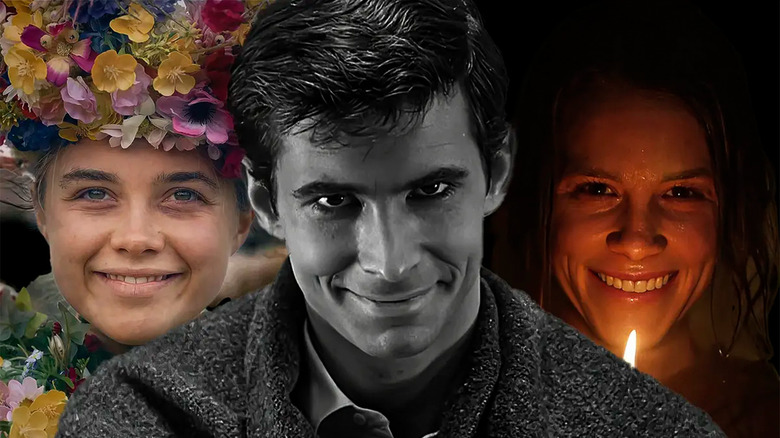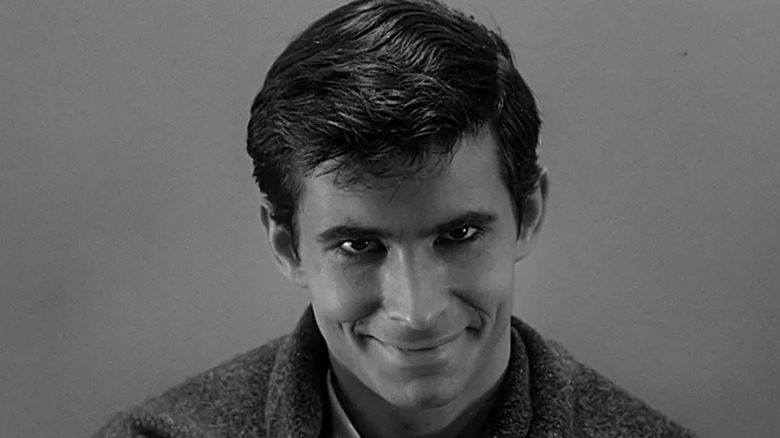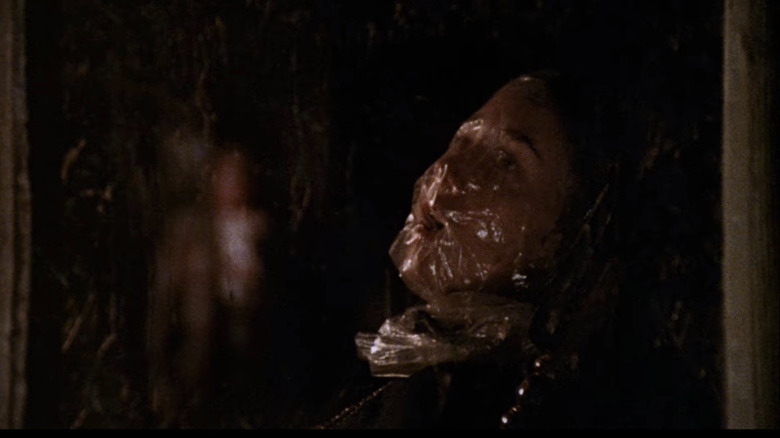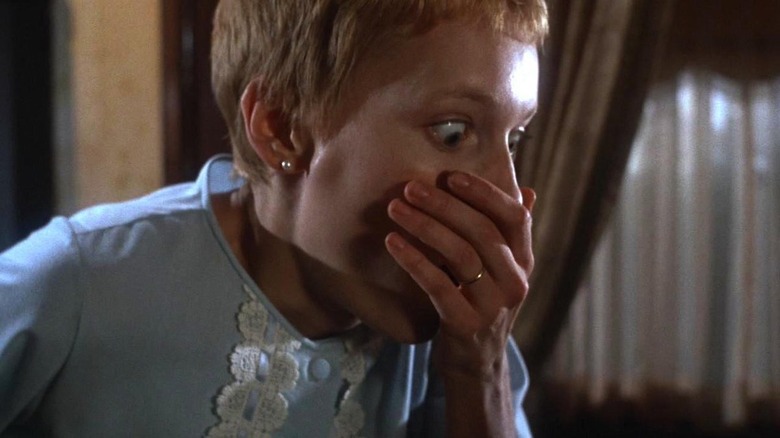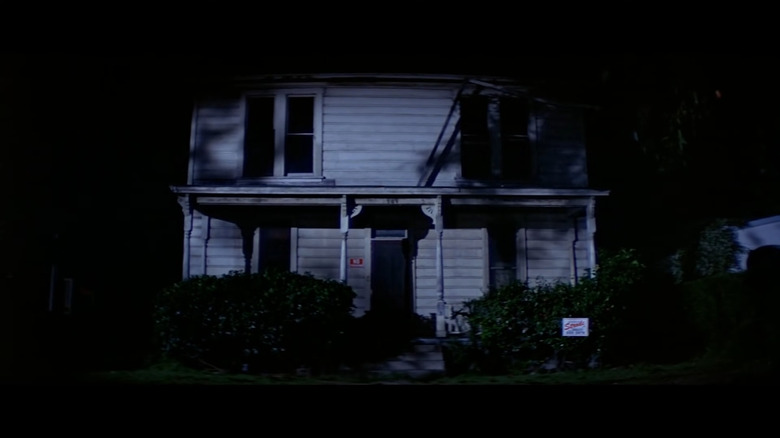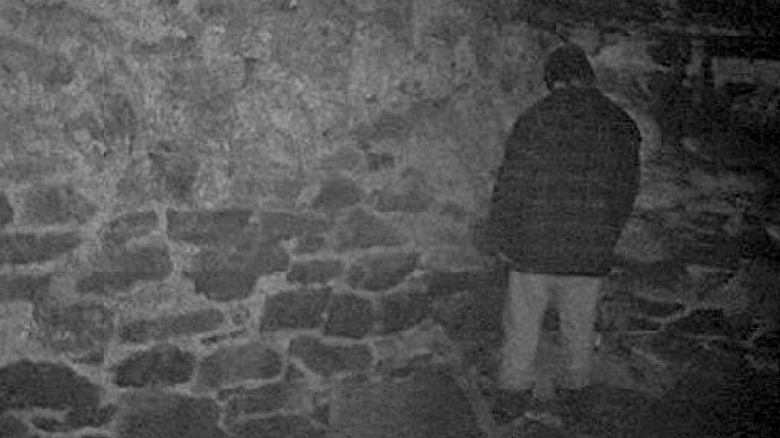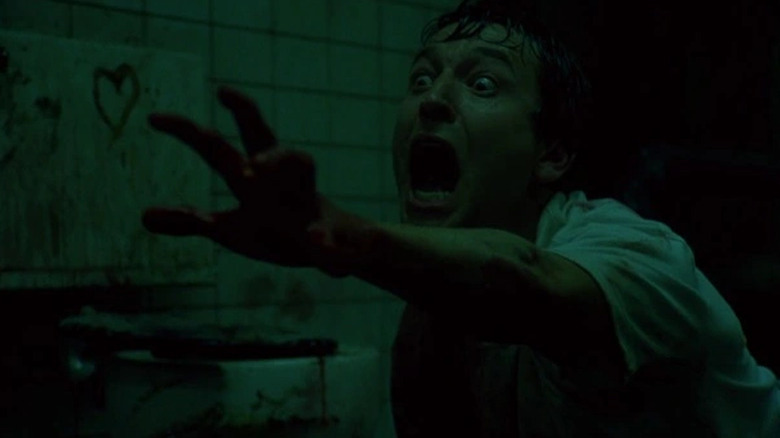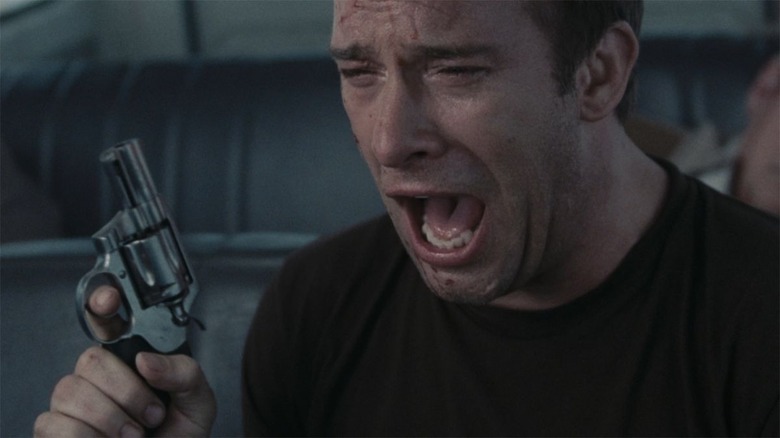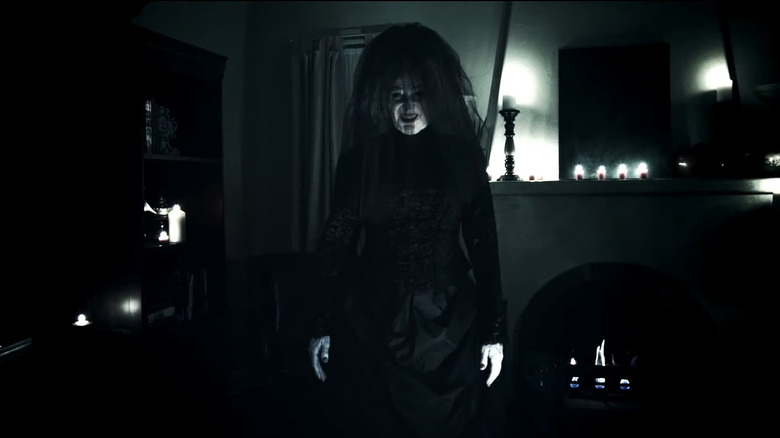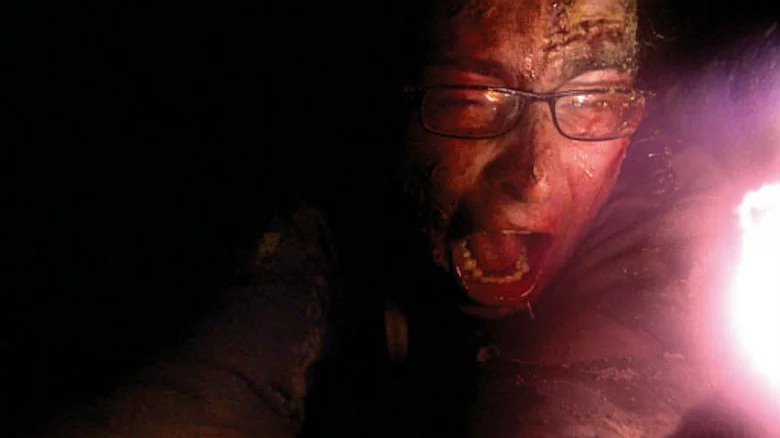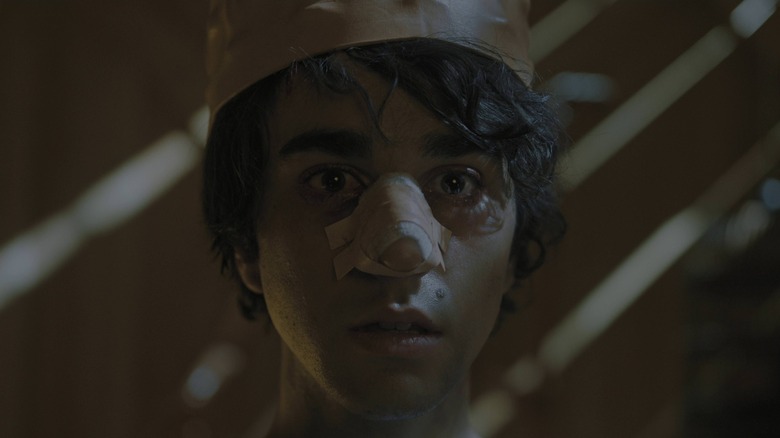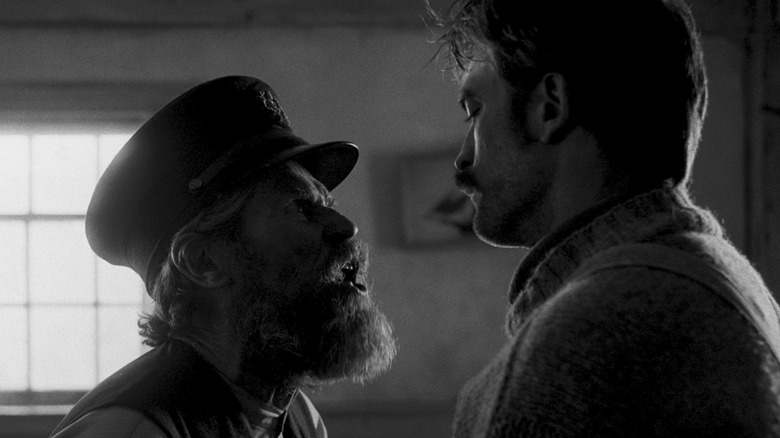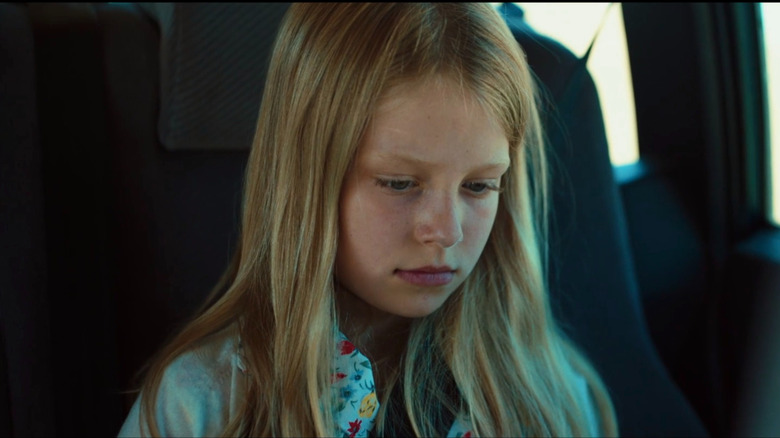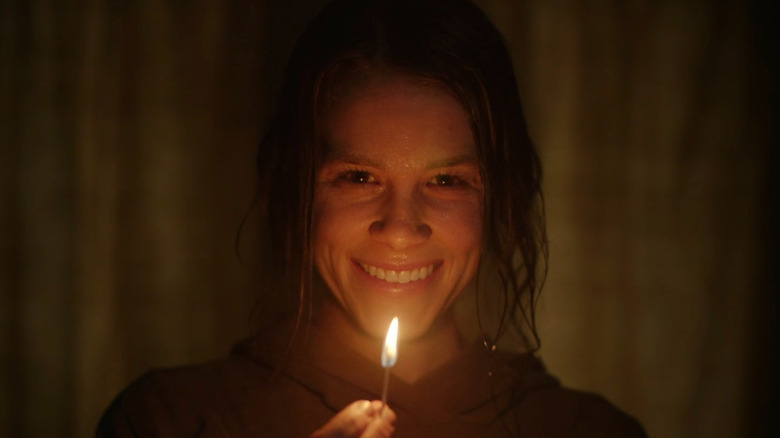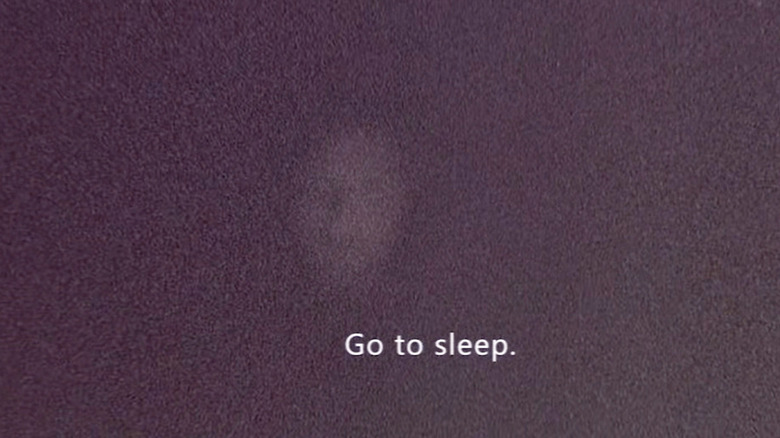15 Horror Movies With Chilling Final Images
This article contains spoilers for the films on this list.
Like comedy, the horror genre is a category of film that heavily relies on setup and payoff. Much like the punchline to a good joke, the horrific images presented on screen can make or break a scary movie. This holds especially true when it comes to a film's final shot, as it'll be the last image the audience sees before the credits roll.
If the final image has stuck with the audience long after the screen faded to black, then the director has done his job right. Whether it's kids skipping rope in "A Nightmare on Elm Street" or Bagul's final jumpscare in "Sinister," the last shot is an important one. From the early days of the horror genre to its current era, there is no shortage of effectively disturbing images that have closed out some spine-tingling movies. So click off the lights and grab a cold soda as we dig into 15 horror movies with chilling final images.
Psycho
Hitchcock was the master of maximizing every tool at his disposal to keep viewers at his artistic mercy. "Psycho" is a film that presents itself as one thing before taking a sharp left turn into something completely different. The movie tells the tale of the final days of Marion Crane (Janet Leigh), a woman who skips town with a sizable sum of stolen money. This scheme leads her to the Bates Motel one rainy night, where she meets the friendly yet off-putting Norman Bates (Anthony Perkins).
Following Marion's demise in the now-legendary shower scene, we believe that Norman's disturbed mother caused it. But later in the film, we're told that Norma Bates has been dead and buried for several years. We even see Marion's sister (Vera Miles) discovering Norma's rotting corpse in the basement during the film's climax. The audience then learns that Norman has a disassociative disorder — operating as himself at times, and at others, as a version of his late mother. The film closes with Norman's inner monologue, noting, "She wouldn't harm a fly." The film closes with an unnerving final image of Norman smiling, with his mother's skull fading over his face.
If you or someone you know needs help with mental health, please contact the Crisis Text Line by texting HOME to 741741, call the National Alliance on Mental Illness helpline at 1-800-950-NAMI (6264), or visit the National Institute of Mental Health website.
Black Christmas
Which film is the first true slasher film has sparked a lot of debate. Technically, "Black Christmas" isn't the first slasher but it's nevertheless a trendsetter — holding the distinction of being one of the earliest holiday-themed horror films. Undeniably, it's one of the earliest examples of a horror film using Christmas as an ironic backdrop for its mayhem.
"Black Christmas" follows a sorority house menaced by a depraved stalker turned serial killer known as The Moaner. Throughout the film, The Moaner, aka Billy, harasses the house with sexually depraved phone calls. His harassment eventually turns into straight-up murder. One by one, the bodies pile up via sickening means.
Throughout the film, we are never shown what Billy looks like aside from a few brief glimpses of his eyes. At one point, we're led to believe that he's Peter (Keir Dullea), the boyfriend of the final girl Jess (Olivia Hussey). He's even killed by her in her confusion. However, in the film's final moments, we see Billy still in the attic of the sorority house. He creepily sings "O'Holy Night." The film ends with Billy making another call to the house, leaving us with the haunting sound of the phone ringing and Jess' (debatable) demise.
Rosemary's Baby
"Rosemary's Baby" is one of those films that's so hypnotically disturbing, it feels like you've descended into a darker realm. Based on Ira Levin's 1967 novel, the film follows Rosemary (Mia Farrow) and her husband Guy (John Cassavetes), moving into a lavish New York apartment to grow their family.
Almost immediately, Rosemary is put off by their strange new neighbors, the Castevets. However, Guy chastises her for being rude. Following some drugged chocolate mousse, Rosemary seems to be sexually assaulted by a mysterious entity as Guy and other tenants watch while naked. Following this, Rosemary learns she's pregnant. The Castevets take an overly active interest in her well-being. She soon realizes the Castevets, as well as other residents, are involved in a satanic cult. Worse, Guy knowingly made his wife the vessel for Satan's baby.
In the film's closing moments, Rosemary finally sees her child. She's told that it "has his father's eyes." She's revolted by this, even going as far as to spit in Guy's face. But she hears the baby crying and then tends to him. We end with the distressing image of Rosemary accepting her new role as the mother of Satan's son.
Halloween
Directed by John Carpenter, "Halloween" was the catalyst for the '80s-craze of slasher movies. Carpenter's barebones approach and iconic score resulted in a simple but effective story.
The film tells the story of Michael Myers (Nick Castle), a young boy institutionalized for murdering his sister on Halloween night in 1963. 15 years later, Michael escapes from the mental asylum. With his therapist, Dr. Loomis (Donald Pleasence), in hot pursuit of him, he returns to his hometown: Haddonfield. Three babysitters, including Laurie Strode (Jamie Lee Curtis), find themselves in Michael's crosshairs. Laurie's friends are slowly picked off as the Halloween night progresses, eventually leaving her as the final girl standing. The climax kicks off when Laurie heads to the house her friends said they'd be at and discover their bodies. Michael then chases Laurie but she makes it back to the house she's babysitting at (almost) undetected.
Following a fake-out ending, Michael rises one last time to menace Strode before being shot by Loomis. Michael then falls out of the window and lands on the grounds below. However, a few seconds later, he disappears — vanishing into the night. The film closes with shots of all the climax's prominent locations as Michael's breathing intensifies.
The Blair Witch Project
Few wide-release horror films have done as much with as little as "The Blair Witch Project" did. Through some guerilla-style filmmaking, a revolutionary viral marketing campaign, and word of mouth, the film became one of 1999's biggest hits.
"The Blair Witch Project" follows three film students — Heather (Rei Hance), Mike (Michael C. Williams), and Josh (Joshua Leonard) — who, as explained via the film's opening title card, went missing while shooting their documentary. We then see their recovered footage which depicts the events that supposedly lead to their disappearance. In the early scenes, the trio interview locals and learn of Rustin Parr, a child killer who made his victims face the corner. As the trio trek deeper into the woods for answers, it soon becomes clear they're in danger. Not only are they lost without a map, but they discover that Josh has gone missing — kicking their paranoia into overdrive.
In the film's closing moments, the remaining filmmakers enter a decrepit house. On the walls, there are bloody handprints and occult symbols. Heather then descends into the basement where she screams after seeing Mike facing the corner. She's then knocked out by an unseen assailant. Much like the rest of the film, the ending presents a disorienting and disturbing final image.
Saw
In the opening of "Saw," we meet Adam (Leigh Whannell) and Dr. Lawrence Gordon (Cary Elwes), two men chained to a decrepit bathroom with zero memory of how they got there. The only other person with them is a dead man laying in the middle of the room. As they explore the space, they discover tapes and clues that reveal they're stuck in Jigsaw's (Tobin Bell) twisted game.
Throughout the movie, it's implied that Jigsaw is Zep (Michael Zep), a creepy orderly employed at the hospital where Dr. Gordon works. The film's climax not only sees Dr. Gordon amputate his foot to escape but Adam beating Zep to death with a toilet lid. After Gordon crawls to freedom, Adam finds another tape in Zepp's pocket. The corpse in the middle of the room then rises, revealing himself to be the real Jigsaw. He then leaves a screaming Adam in the bathroom to die, closing the door and uttering the words "Game over!" It's a masterful twist, despite being literally in front of the audience the entire time, with an epic closing line.
The Mist
In horror, there aren't many names as legendary and beloved as Stephen King. From "The Shining" to "Pet Sematary," the author is a master of human and inhuman terrors. Adaptations of his work, though hit or miss, have resulted in some stellar silver-screen translations. Frank Darabont's "The Mist" is a keeper for many horror buffs, often popping up on lists of favorite King flicks.
"The Mist" follows David Drayton (Thomas Jane), a father who gets stuck in a grocery store with his young son Billy (Nathan Gamble) due to a mysterious mist outside. Trapped with other town citizens, paranoia begins to rise, and a mob mentality rules. Eventually, David and his son, as well as a few others, leave the store and temporarily escape. They return to David's home and find his wife, Steff (Kelly Collins Lintz), dead in the remains of their now-destroyed home.
Stuck in the mist and with all hope depleted, David and the others make a horrific choice — taking their lives, including young Billy. As if on cue, the mist clears and the army rolls in to begin cleanup, leaving a devastated David screaming in agony as the film ends.
Insidious
James Wan's "Insidious" is a stand-out entry in the haunted house subgenre, rife with stellar suspense and unnerving visuals. The film starts off standard enough: A married couple, Josh (Patrick Wilson) and Renai Lambert (Rose Byrne), deal with bizarre occurrences in the house that coincide with their son Dalton (Ty Simpkins) going into a coma. In a move other horror films should take, the family immediately accepts that something supernatural is afoot and move to a new house.
However, it's revealed that it's not the house that's haunted. Josh becomes haunted because he can astrally project himself — making him an attractive vessel to ghosts and demons. Psychic Elise Rainier (Lin Shaye) explains that Dalton's consciousness has been trapped in a realm known as the Further. Josh soon learns he also has this ability and must enter into the Further to save Dalton.
After freeing Dalton from a hideous red-faced creature, Josh encounters his nemesis, a pale woman in black who has haunted him since childhood. Both Josh and Dalton seemingly escape the Further unharmed. But then Elise snaps a quick picture of Josh, enraging him. He proceeds to choke Elise to death, leaving Renai to discover her dead body and the pictures she took. The photo shows the woman in black possessing Josh. The entity approaches Renai from behind as the film cuts to the credits.
The Borderlands
While definitely not unknown by any means, "The Borderlands" still isn't a film known to many horror fans. It's a shame too because the film is a unique blend of found footage and disturbing religious imagery. However, the film shines in its closing moments and sticks its landing.
Deacon (Gordon Kennedy), Gray (Robin Hill), and Father Mark Amidon (Aidan McArdle) comprise a film crew tasked by the Vatican to look into some alleged supernatural activity in a 13th-century church. The crew eventually discovers that the church is the site of a pagan temple used for ritualistic sacrifice. After an exorcism goes wrong, the two remaining filmmakers — Gray and Deacon — descend into the bowels of the church. They follow someone they believe to be their friend Mark through tunnels.
Unfortunately, this is their last stop. The entrance to the tunnel contracts like a human orifice, trapping them. Before the two men have time to get their bearings, they realize the walls are secreting an acidic liquid that burns them. Yes, in a gruesome twist, they have ventured into the literal belly of the beast and are being horrifically digested. The film closes with visceral close-ups of Gray and Deacon screaming and praying for mercy as their flesh melts!
Hereditary
When "Hereditary" hit theaters in 2018, no one expected how viscerally shocking the film would be. The film presents a narrative that goes from unsettling to emotionally draining and ends at downright nightmare-inducing by its third act.
In the film's closing scenes, everything plaguing the Graham family comes to a tragic conclusion. The father burst into flames. This coincides with the mother, Annie (Toni Collette), being possessed and attempting to kill her son. Her son, Peter (Alex Wolff), is set to be the vessel for the figure of her mother's cult: Paimon.
By the film's end, Peter awakens from an injury-induced snooze to discover his father's charred corpse. He's then confronted by a naked cult member and a possessed Annie who chases him up to the attic. Peter then sees Annie cutting her head off, before being scared by more cultists. Peter is then possessed by Paimon — making the same clicking sound that his sister Charlie (Milly Shapiro) did — and enters the treehouse where the cultists are waiting. Peter stands at an altar constructed with the remains of his sister, mother, and grandmother as the cultists praise him.
Midsommar
Hello again, Ari Aster! The director makes his way twice on this list, thanks to his trippy film, "Midsommar." The film deftly holds back its sinister hand until its shocking conclusion.
"Midsommar" follows Dani (Florence Pugh), a woman grieving the recent death of her sister and her parents' murder. She goes on a trip with her boyfriend, Christian (Jack Reynor), and his friends to a midsummer festival in Sweden. As the festival continues, Dani's PTSD worsens, made no easier by Christian's dismissive attitude — he clearly wants out of the relationship. Things take a turn for the messed up worse when the commune begins axing off Christian's friends. Aster's film culminates with Dani, having been crowned May Queen, facing a disturbing decision: Choose Christian or a commune member to be the final sacrifice for their cleansing ritual.
Mentally frayed and emotionally wounded by his cheating on her with a commune member, Dani swiftly chooses Christian. He is then stuffed inside of a bear's hollowed-out body and left in the commune's temple to burn alongside two volunteers. The film closes out with the commune members reveling in the ritual's completion. Dani's smile grows wider as the temple burns. In the long legacy of disturbing horror movie smiles, Pugh definitely gives Anthony Perkins a run for his money.
The Lighthouse
From beginning to end, Robert Eggers' "The Lighthouse" keeps the viewer in an intentionally prolonged state of confusion and fear. The bizarre thing about the film is, like "Midsommar," it doesn't really become a horror flick until its latter half. Up until then, the film stays its course as a character drama between two men stuck tending to a lighthouse for four weeks.
Ephraim Winslow (Robert Pattinson) and his boss, Thomas Wake (Willem Dafoe), immediately begin rubbing each other the wrong way. Between Wake's domineering attitude and his constant farting, Ephraim slowly begins to unravel — even seeing images of a seductive mermaid in his dreams. As the film reaches its halfway point, the line between fantasy and reality erodes. Both men question each other's sanity. The viewer feels confused as the film never really makes it clear which man is lying and which isn't.
At one point Wake teases Ephraim — his real name revealed to be Thomas — that he could simply be hallucinating all of this while dying somewhere. In the film's final scene, Thomas disposes of Wake and finally enters the Lighthouse's top area to see the light. This proves to be too much for him and he's sent tumbling down the lighthouse stairs before the film fades to an emaciated Thomas lying naked on some rocks. The film then closes with the visual of some seagulls feasting on his eyes and organs, which we cannot show you here.
Speak No Evil
Nothing beats a film that leaves you feeling like you've taken a shotgun blast to the sternum. "Speak No Evil" is one of those films and is the perfect thing to watch if you want to ruin your week.
For those still reading, the film follows Bjørn (Morten Burian) and Louise (Sidsel Siem Koch), a married couple with a daughter named Agnes (Liva Forsberg). While vacationing in Tuscany, the family meets Patrick (Fedja van Huêt), Karin (Karina Smulders), and their son, Abel (Marius Damslev) who seems to be mute. Bjørn and Louise opt to take them up on their offer to visit their home in the Netherlands and things go sideways fast. Patrick and Karin are far from the best hosts, insulting Louise's dietary preferences and openly swearing in front of Agnes.
The uncomfortable nature of the visit increases until Bjørn discovers that their hosts are definitely evil. He discovers a trove of old pictures of Patrick and Karin with other tourist families, all with children, that they have kidnapped in a sickening cycle. This cycle, unfortunately, repeats. By the end of the film, Patrick and Karin cut out Agnes' tongue before killing Bjørn and Louise. The film ends as it began with an emotionally withered, and permanently silenced Agnes, serving the same role that Abel did as her "new parents" introduce themselves to a new family.
Smile
"Smile" follows Rose (Sosie Bacon), a psychiatrist whose life takes a turn for the horrific following the death of her latest patient. Adding to the horror is the fact that the patient flashed the creepiest of smiles at Rose before she takes her own life. Rose's sanity steadily erodes as she sees more and more people smiling everywhere she goes.
Given how she's the only one who can see these apparitions, no one in Rose's life, aside from her ex-boyfriend Joel (Kyle Gallner), offers much help. She soon discovers she's been cursed and will be the next to die in a cycle set in motion by an entity that feeds on trauma.
"Smile" reaches its climax when Rose thinks she has defeated the entity. Alas, it's revealed to be a sinister fake-out. The entity, a sickening creature with several rows of teeth, proceeds to possess Rose by climbing into her mouth. Joel arrives just in time to see Rose, now sporting a creepy smile, douse herself in kerosene before lighting herself on fire.
Skinamarink
"Skinamarink" is a horror film that has divided the internet. Some hail it as a nightmarish masterwork while others lambast it as an unwatchable snoozefest. Regardless of how you felt about it, there's no denying the success of "Skinamarink." The indie film grossed two million dollars against its minuscule $15,000 budget.
The film's plot focuses on two young siblings, Kevin (Lucas Paul) and Kaylee (Dali Rose Tetreault), stuck in a nightmarish situation. In the middle of the night, their father and all exits to the house mysteriously vanish, leaving the kids isolated. To pass the time, the siblings hold up on the couch in their living room for days while watching old cartoons. However, soon a mysterious voice beckons to them. The voice tells them each to "come upstairs," which results in some creepy moments.
As the film reaches its conclusion, it's revealed that Kevin has been trapped and suffering at the hands of this evil entity for 572 days. We're then shown a dark screen, presumably from Kevin's point of view, with a distorted white face barely visible through the static. Kevin weakly asks for the entity's name but is only met with silence. An "The End" card suddenly appears, closing out the film. The film chooses to leave you in the same place as poor Kevin, hopelessly confused, terrified, and bereft of any real answers.
